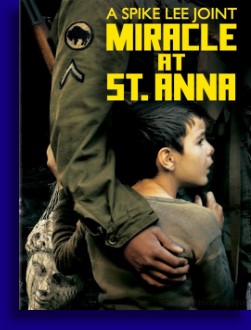

Reviewed by
Christopher Armstead


For this Spike Lee went off on Clint Eastwood. Everything Spike Lee does film-wise I attempt to watch because I’m of the belief that the man is a very important filmmaker. The successes such as ‘Do the Right Thing’ or the ridiculously great ‘The 25th Hour’, and even his disasters which I present to you in the form of ‘Bamboozled’ or perhaps ‘Girl 6’. So when Spike took his jabs at the ancient Dirty Harry, criticizing his films for their failure to properly represent the African American soldier’s experience during WWII, with Spike knowing full well that that with ‘Flags of our Fathers’ and ‘Letters from Iwo Jima’ that there was little place for Black soldiers in those particular stories in the heavily segregated 1940’s, I was more than curious to see what Spike had in store for us with his WWII war film ‘Miracle at St. Anna’. Now this movie was far from a disaster and it certainly had its inspired moments, but one has to think that in the hands of Harry Callahan, this would have been an infinitely better movie.
In 1983 elderly postal worker Hector Negron (Laz Alonzo) is dutifully doing his job when some old dude walks up to his window to buy some stamps to which Hector pulls out a Luger and puts one square into my man’s frontal lobe. Talk about the stars being lined up wrong for a guy, since one has to think that the chances of finding that particular postal worker at that particular post office on that particular day in over populated New York City has to be pretty darned slim. Cub reporter Tim Boyle (Joseph Gordon-Levitt) manages to get some personal time with the now institutionalized for being criminally insane Hector Negron, who has been nothing less than a model citizen for majority of his life, thus leading Boyle needing to know why this mild-mannered man killed this old dude and why he had a priceless Italian artifact on the floor of his closet. Reticent at first but Hector has a heckuva story to tell.
In Italy during WWII a battalion of African American soldiers known as the Buffalo regiment are on a recon mission and are ambushed by a heavily armed team of



German soldiers. The slaughter is pretty much complete with only four soldiers managing to survive who find themselves wandering through the wooded hills of Italy. These soldiers are the afore mentioned Cpl. Hector Negron, defacto leader Aubrey Stamps (Derek Luke), never-do-well slickster Sgt. Bishop Cummings (Michael Ealy) and the simpleton man mountain Pvt. Sam Train (Omar Benson Miller) who has earlier found our priceless artifact and is carrying it around, correctly figuring it to be worth a couple of bucks.
Soon Pvt. Train will find and rescue an injured Italian boy named Angelo (Matteo Sciabordi) who Train swears is a good luck charm and thus carries him along with our quartet everywhere they go. Where they will go will be to a small Italian village where they will meet the lovely Renata (Valentina Cervi), who both Sgt. Stamps and Sgt. Cummings are sweet on, though for different reasons. The soldiers will also meet Renata’s family and encounter some Italian freedom fighters who happen to have a Nazi prisoner in tow – who has as secret - as they all try to avoid the oncoming Nazi onslaught amidst some rather suspect orders from their idiot commanding officer.
Since Spike Lee’s film is all over the freaking the place, it’s difficult to pin down exactly what you’re watching at any given moment and equally difficult to discuss in a reasonable way exactly what you’ve just seen, but coherence has never been a strong point of mine anyway so here goes. ‘The Miracle at St. Anna’ is many things. It’s a war movie, it’s a comedy, it’s a fantasy, it’s a treatise on the politics of race abroad during World War II, it’s an attack on the politics of race back home in the segregated United States during this time, it’s an examination of Nazi atrocities, of fascism and of sexual lust. Yes, ‘The Miracle at St. Anna’ is all of those things and more which is why at a shade under three hours long it was all at once far too lengthy and not long enough to give all these disparate elements anything but a fancy glossing over.
Based on a novel by author James McBride, who also wrote the screenplay, this could have been one of the problems since it seems as if McBride wanted to get all the major points that were in his novel into his screenplay, and though I’m fairly certain what was focused and clear in 320 pages of prose, is unfocused and meandering in three hours of film stock. There was one interesting scene in which a general played by actor Robert John Burke was having a discussing on the validity of the Black soldier during WWII with his Colonel played by D.B. Sweeney, however despite the promise that scene held that was pretty much it for that. There were a few scenes along those lines that had promise and looked as if they were heading someplace in particular only to die a sad and lonely death. There was just so much material that Lee was trying to cover and so many things going on, that film suffered mightily for it.
This is a Spike Lee movie
and Lee is a veteran and accomplished film director so
we can take for granted that the film is shot
beautifully, the set design was impeccable and the
actors did well with their roles, though they too
suffered in the translation as there wasn’t really
enough time given to the individual actor to make them
anything more than glorified caricatures. However,
despite the somewhat oppressive length of this film, at
no time in my opinion did it ever become dull or
unwatchable as Mr. Lee still knows how to keep a film in
constant motion.
The problem with ‘The Miracle at St. Anna’ was just that it seemed as if the director had TOO much story to work with and not enough time properly tell it, and he also didn’t have the heart to leave the stuff on the cutting room floor that would’ve inevitably made for a much better film. I’m thinking Dirty Harry wouldn’t have had that problem.
